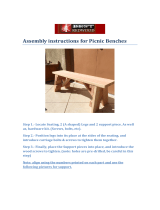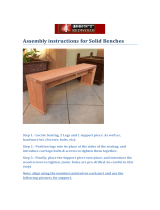
V200 XL
2012-02
Page1
Contents
Preface ................................................................................................. 2
1 Productdescription .................................................................. 3
1.1 Intended Use ................................................................................................................ 3
1.2 Technical specifications .............................................................................................. 4
1.3 Drawing ....................................................................................................................... 5
1.4 Accessories .................................................................................................................. 6
1.5 Location identification plate ........................................................................................ 6
1.6 Explanation of symbols ............................................................................................... 6
2 Use ............................................................................................. 6
2.1 Carrying the wheelchair .............................................................................................. 6
2.2 Mounting the rear wheels ............................................................................................ 7
2.3 Unfolding the wheelchair ............................................................................................ 7
2.4 Mounting or removing of push bar ............................................................................. 7
2.5 Mounting or removing of the footrests ....................................................................... 8
2.6 Operating the brakes .................................................................................................... 8
2.7 Mounting or removing of arm supports ...................................................................... 9
2.8 Transfer in and out the wheelchair ............................................................................ 10
2.9 Correct position in the wheelchair ............................................................................ 10
2.10 Riding the wheelchair ................................................................................................ 10
2.11 Moving on slopes ...................................................................................................... 11
2.12 Negotiating steps or curbs ......................................................................................... 11
2.13 Fold up the wheelchair .............................................................................................. 13
2.14 Taking off the wheels ................................................................................................ 13
2.15 Transport in the car .................................................................................................... 13
3 Installation and adjustment .................................................. 14
3.1 Tools .......................................................................................................................... 14
3.2 Manner of delivery .................................................................................................... 14
3.3 Adjusting the seat height and seat angle ................................................................... 14
3.4 Adjust the brakes ....................................................................................................... 17
3.5 Adjusting of the footrests .......................................................................................... 17
3.6 Adjusting the arm support ......................................................................................... 18
4 Maintenance ........................................................................... 19
4.1 Regular Maintenance ................................................................................................. 19
4.2 Shipping and storage ................................................................................................. 19
4.3 Care ........................................................................................................................... 20
4.4 Inspection .................................................................................................................. 20
4.5 Disinfection ............................................................................................................... 21
5 Guarantee ............................................................................... 23
6 Disposal ................................................................................... 23
7 Declaration of conformity ..................................................... 23
8 Maintenance plan .................................................................. 24
9 Disinfection book ................................................................... 24























